Genetic K-Means Clustering of Soil Gas Anomalies for High-Enthalpy Geothermal Prospecting: A Multivariate Approach from Southern Tenerife, Canary Islands
Abstract
1. Introduction
2. Geological and Structural Setting
3. Materials and Methods
3.1. Soil Gas Survey and Analytical Techniques
- Major gas species (volume % or ppm): He, H2, O2, N2, CO2, and CH4. These were analyzed by gas chromatography (for H2, O2, N2, CH4, and CO2 in the collected samples) and a mass spectrometer for He.
- O2 and N2 mainly represent atmospheric components, but depletion of O2 or enrichment of N2 beyond atmospheric ratios can indicate biological activity or injection of volcanic gases. Helium, hydrogen, and methane in soil gas are typically very low in normal air; any significant enhancement suggests deep or crustal processes (He is a key indicator of magmatic contributions, and H2 indicates redox conditions and water–rock interaction at depth).
- Argon isotopic composition (36Ar, 38Ar, and 40Ar): measured via a quadrupole mass spectrometer. The isotopic ratios of argon can reveal excess radiogenic 40Ar or air-derived Ar, helping to distinguish atmospheric vs. mantle sources of the gases.
- Carbon isotopic ratio of CO2 (δ13C-CO2): analyzed with an isotope ratio mass spectrometer. δ13C values in CO2 help differentiate between biogenic (soil respiration, typically 13C-depleted) and deep magmatic or limestone-derived CO2 (often 13C-enriched). In our context, magmatic CO2 typically has δ13C around −4 to −8‰ vs. VPDB, whereas biogenic CO2 is ~−25‰; thus, isotopically heavy CO2 anomalies can indicate a deep magmatic carbon contribution.
3.2. Geochemical Anomaly Threshold Determination (Sinclair Method)
3.3. Origin of CO2: Isotopic Evidence and Mixing Model Interpretation
3.4. From Univariate Thresholds to Multivariate Classification in Geochemical Analysis
3.5. Multivariate Clustering Analysis in Geothermal Exploration
3.5.1. K-Means Algorithm (TKM)
3.5.2. Genetic K-Means Clustering Algorithm (GKMC)
3.5.3. Fitness Function Evolution in GKMC
- ∣Ck∣: number of samples in cluster k.
- Nmín: minimum acceptable cluster size.
- α: penalty exponent (typically 2 or 3).
- λ: weighting factor controlling the impact of the penalty in the total fitness function.
4. Results
4.1. Soil Gas Geochemical Characterization and Probabilistic Population Analysis
4.2. Multivariate Clustering of Soil Gas Data: GKMC Algorithm
4.3. Variable Selection and Methodological Rationale
- CH4 (methane) was consistently found near detection limits (~0.7 ppm) throughout the dataset, indicating limited spatial or geochemical variability. Its low concentrations and potential biogenic or anthropogenic origin diminish its value as a tracer of magmatic or geothermal processes.
- O2 (oxygen) is overwhelmingly atmospheric in origin. Its presence in soil gas is governed by near-surface processes, such as soil-atmosphere exchange and microbial consumption, and therefore lacks diagnostic power in identifying deep-sourced anomalies.
- H2, while sometimes used as a redox-sensitive indicator in geothermal systems, is highly reactive and susceptible to local oxidation–reduction reactions in the shallow subsurface. This reactivity can obscure any potential signals from deep degassing sources, particularly in settings with complex soil hydrology or vegetation.
- CO2 is a major component of volcanic and hydrothermal gases and can traverse significant depths due to its mobility.
- He is a well-established indicator of magmatic input, especially when concentrations exceed atmospheric levels (~5.24 ppm).
- 222Rn serves as a proxy for subsurface permeability and the presence of fracture systems facilitating vertical gas migration.
- δ13C–CO2 enables the distinction between biogenic and magmatic carbon sources, with heavier values (closer to 0‰) indicating a deeper origin.
4.4. Clustering Outcomes and Structure
- Cluster 0 (Red): This group comprises a small fraction of the dataset (~5%) but is characterized by co-occurring high CO2 fluxes, enriched He concentrations (≥15 ppm), elevated δ13C values (up to −6‰), and significant 222Rn activity. These geochemical signatures strongly suggest a magmatic-hydrothermal contribution, associated with enhanced vertical permeability along fault zones or deep-seated fracture networks. This cluster is interpreted as the primary geochemical expression of potential geothermal upflow zones.
- Cluster 1 (Orange): Accounting for approximately 10% of the samples, this group shows intermediate values in all key parameters—e.g., CO2 fluxes around 50 g·m⁻2·d⁻1, δ13C values near −10‰, and modest He enrichment (~7 ppm). These sites are interpreted as transitional zones or halos surrounding more active degassing centers, reflecting areas of mixed gas sources or moderate permeability conditions.
- Cluster 2 (Dark Gray): Representing the background geochemical population (~85% of data), this cluster is marked by low CO2 flux, near-atmospheric He concentrations (~5.2 ppm), low 222Rn activity, and δ13C values around −25‰. These signatures are consistent with soil gas compositions dominated by biological activity, atmospheric mixing, and low subsurface gas input. The spatial distribution of this cluster covers most of the study area, especially the structurally unremarkable zones.
4.5. Stability and Robustness of GKMC Clustering
5. Discussion: Structural and Spatial Interpretation of GKMC Clusters
5.1. Cluster 0—Deep Geochemical Anomalies Controlled by Fault Intersections
5.2. Cluster 1—Transitional Zones Reflecting Partial Deep Input
5.3. Cluster 2—Regional Background and Structural Stability
5.4. Implications for Exploration and Conceptual Model Development
6. Conclusions
- Discrete Geochemical Zonation via Multivariate Clustering. The application of GKMC to key parameters (CO2, He, 222Rn, and δ13C–CO2) yielded a robust three-cluster solution. Cluster 0 defines geochemically coherent, spatially restricted anomalies associated with deep magmatic-hydrothermal contributions. Cluster 1 corresponds to transitional zones influenced by partial deep inputs, while Cluster 2 represents regional background conditions dominated by biogenic and atmospheric components.
- Structural Control on Fluid Migration. The spatial distribution of Cluster 0 correlates strongly with the intersection of NW–SE and NE–SW fault systems, historically recognized as preferential pathways for vertical gas migration in Tenerife’s volcanic edifice. These findings reinforce the structural control hypothesis in governing subsurface fluid dynamics.
- Subtle but Meaningful Geochemical Anomalies. Although individual gas parameters exhibit low proportions of anomalous values (e.g., only 2.1% for CO2 flux), the multivariate clustering approach revealed consistent geochemical signals that would be overlooked through univariate analysis. This underscores the value of integrated, data-driven methodologies in detecting “hidden” geothermal systems without surface hydrothermal manifestations.
- Methodological Robustness and Exploratory Value. The GKMC algorithm demonstrated robust performance in managing noisy, multivariate geochemical datasets. Its capacity to isolate subtle anomalies embedded within dominant background populations highlights its utility in early-stage geothermal exploration, particularly in volcanic and data-scarce environments.
- Next Steps in Geothermal Assessment. While the geochemical results do not suggest a large or high-enthalpy reservoir, the identification of localized, structurally controlled deep gas emissions justifies further investigation. Combining these findings with complementary techniques—such as magnetotelluric imaging, shallow gradient drilling, and passive seismic monitoring—will help refine the conceptual subsurface model and better characterize reservoir properties. The methodology presented here may also be applied to other oceanic volcanic islands with similar geodynamic settings, such as El Hierro or La Palma.
Future Studies
Author Contributions
Funding
Data Availability Statement
Acknowledgments
Conflicts of Interest
References
- Nicholson, K. Geothermal Fluids: Chemistry and Exploration Techniques; Springer: Berlin/Heidelberg, Germany, 1993. [Google Scholar] [CrossRef]
- Fridriksson, T.; Padrón, E.; Óskarsson, F.; Pérez, N.M. Application of diffuse gas flux measurements and soil gas analysis to geothermal exploration and environmental monitoring: Example from the Reykjanes geothermal field, SW Iceland. Renew. Energy 2016, 86, 1295–1307. [Google Scholar] [CrossRef]
- Bertrami, R.; Buonasorte, G.; Ceccarelli, A.; Lombardi, S.; Pieri, S.; Scandiffio, G. Soil gases in geothermal prospecting: Two case histories (Sabatini Volcanoes and Alban Hills, Latium, Central Italy). J. Geophys. Res. Solid Earth 1990, 95, 21475–21481. [Google Scholar] [CrossRef]
- Voltattorni, N.; Quattrocchi, F.; Sciarra, A. The application of soil gas technique to geothermal exploration: Study of “hidden” potential geothermal systems. In Proceedings of the Proceedings World Geothermal Congress, Bali, Indonesia, 25–30 April 2010; Available online: https://www.researchgate.net/publication/228361425 (accessed on 23 March 2024).
- Rodríguez, F.; Pérez, N.M.; Melián, G.V.; Padrón, E.; Hernández, P.A.; Asensio-Ramos, M.; Padilla, G.D.; Barrancos, J.; D’Auria, L. Exploration of deep-seated geothermal reservoirs in the Canary Islands by means of soil CO2 degassing surveys. Renew. Energy 2021, 164, 1017–1028. [Google Scholar] [CrossRef]
- Pérez, N.M.; Hernández, P.A.; Padrón, E.; Melián, G.; Nolasco, D.; Barrancos, J.; Padilla, G.; Calvo, D.; Rodríguez, F.; Dionis, S.; et al. An increasing trend of diffuse CO2 emission from Teide volcano (Tenerife, Canary Islands): Geochemical evidence of magma degassing episodes. J. Geol. Soc. 2013, 170, 585–592. [Google Scholar] [CrossRef]
- Pérez, N.M.; Hernández, P.A.; Padrón, E.; Melián, G.; Marrero, R.; Padilla, G.; Barrancos, J.; Nolasco, D. Precursory subsurface 222Rn and 220Rn degassing signatures of the 2004 seismic crisis at Tenerife, Canary Islands. Pure Appl. Geophys. 2007, 164, 2431–2448. [Google Scholar] [CrossRef]
- Sinclair, A.J. Selection of threshold values in geochemical data using probability graphs. J. Geochem. Explor. 1974, 3, 129–149. [Google Scholar] [CrossRef]
- Rodríguez, F.; Pérez, N.M.; Padrón, E.; Melián, G.; Piña-Varas, P.; Dionis, S.; Barrancos, J.; Padilla, G.D.; Hernández, P.A.; Marrero, R.; et al. Surface geochemical and geophysical studies for geothermal exploration at the southern volcanic rift zone of Tenerife, Canary Islands, Spain. Geothermics 2015, 55, 195–206. [Google Scholar] [CrossRef]
- Rodríguez, F.; Pérez, N.M.; Padrón, E.; Melián, G.; Hernández, P.A.; Asensio-Ramos, M.; Dionis, S.; López, G.; Marrero, R.; Padilla, G.D.; et al. Diffuse helium and hydrogen degassing to reveal hidden geothermal resources in oceanic volcanic islands: The Canarian archipelago case study. Surv. Geophys. 2015, 36, 351–369. [Google Scholar] [CrossRef]
- Ciotoli, G.; Etiope, G.; Guerra, M.; Lombardi, S. The detection of concealed faults in the Ofanto Basin using the correlation between soil-gas fracture surveys. Tectonophysics 1999, 301, 321–332. [Google Scholar] [CrossRef]
- Hernández, P.A.; Pérez, N.M.; Salazar, J.M.; Nakai, S.; Notsu, K.; Wakita, H. Diffuse emission of carbon dioxide, methane, and helium-3 from Teide Volcano, Tenerife, Canary Islands. Geophys. Res. Lett. 2000, 27, 2389–2392. [Google Scholar] [CrossRef]
- Hernández, P.; Pérez, N.; Salazar, J.; Reimer, M.; Notsu, K.; Wakita, H. Radon and helium in soil gases at Cañadas caldera, Tenerife, Canary Islands, Spain. J. Volcanol. Geotherm. Res. 2004, 131, 59–76. [Google Scholar] [CrossRef]
- Reimann, C.; Filzmoser, P.; Garrett, R.; Dutter, R. Statistical Data Analysis Explained: Applied Environmental Statistics with R; John Wiley & Sons: Hoboken, New Jersey, USA, 2011; Available online: https://books.google.es (accessed on 20 February 2022).
- Di Giuseppe, M.G.; Troiano, A.; Patella, D.; Piochi, M.; Carlino, S. A geophysical k-means cluster analysis of the Solfatara-Pisciarelli volcano-geothermal system, Campi Flegrei (Naples, Italy). J. Appl. Geophys. 2018, 156, 44–54. [Google Scholar] [CrossRef]
- Finlayson, J.B. A soil gas survey over Rotorua geothermal field, Rotorua, New Zealand. Geothermics 1992, 21, 27–41. [Google Scholar] [CrossRef]
- Ghezelbash, R.; Maghsoudi, A.; Carranza, E.J.M. Optimization of geochemical anomaly detection using a novel genetic k-means clustering (GKMC) algorithm. Comput. Geosci. 2020, 134, 104335. [Google Scholar] [CrossRef]
- Ghezelbash, R.; Maghsoudi, A.; Shamekhi, M.; Pradhan, B.; Daviran, M. Genetic algorithm to optimize the SVM and K-means algorithms for mapping of mineral prospectivity. Neural Comput. Appl. 2023, 35, 719–733. [Google Scholar] [CrossRef]
- Araña, V.; Ortiz, R. The Canary Islands: Tectonics, Magmatism and Geodynamic Framework. In Magmatism in Extensional Structural Settings: The Phanerozoic African Plate; Springer: Berlin/Heidelberg, Germany, 1991; pp. 209–249. [Google Scholar] [CrossRef]
- Carracedo, J.C. The Canary Islands: An example of structural control on the growth of large oceanic-island volcanoes. J. Volcanol. Geotherm. Res. 1994, 60, 225–241. [Google Scholar] [CrossRef]
- Anguita, F.; Hernán, F. The Canary Islands origin: A unifying model. J. Volcanol. Geotherm. Res. 2000, 103, 1–26. [Google Scholar] [CrossRef]
- Fuster, J.M.; Hernández-Pacheco, A.; Muñoz, M.; Rodríguez Badiola, E.; García Cacho, L. Geología y Volcanología de las Islas Canarias: Gran Canaria; Instituto “Lucas Mallada” (CSIC): Zaragoza, Spain, 1968; Available online: http://hdl.handle.net/10261/3307 (accessed on 15 April 2023).
- Ancochea, E.; Fuster, J.M.; Ibarrola, E.; Cendrero, A.; Coello, J.; Hernán, F.; Cantagrel, J.M.; Jamond, C. Volcanic evolution of Tenerife (Canary Islands) in the light of new K-Ar data. J. Volcanol. Geotherm. Res. 1990, 44, 231–249. [Google Scholar] [CrossRef]
- Dóniz, J.; Romero, C.; Coello, E.; Guillén, C.; Sánchez, N.; García-Cacho, L.; García, A. Morphological and statistical characterisation of recent mafic volcanism on Tenerife (Canary Islands, Spain). J. Volcanol. Geotherm. Res. 2008, 173, 185–195. [Google Scholar] [CrossRef]
- Kröchert, J.; Buchner, E. Age distribution of cinder cones within the Bandas del Sur Formation, southern Tenerife, Canary Islands. Geol. Mag. 2008, 146, 161–172. [Google Scholar] [CrossRef]
- Martín-Lorenzo, A.; Rodríguez, F.; Alonso, M.; Amonte, C.; Melián, G.V.; Asensio-Ramos, M.; Padrón, E.; Hernández, P.A.; Pérez, N.M. A detailed soil gas physical-chemical survey for geothermal exploration at Tenerife, Canary Islands. In Proceedings of the 23rd EGU General Assembly, Online, 19–30 April 2021; p. EGU21-15066. [Google Scholar] [CrossRef]
- Ablay, G.J.; Martı, J. Stratigraphy, structure, and volcanic evolution of the Pico Teide–Pico Viejo formation, Tenerife, Canary Islands. J. Volcanol. Geotherm. Res. 2000, 103, 175–208, ISSN 0377-0273. [Google Scholar] [CrossRef]
- Chiodini, G.; Cioni, R.; Guidi, M.; Raco, B.; Marini, L. Soil CO2 flux measurements in volcanic and geothermal areas. Appl. Geochem. 1998, 13, 543–552. [Google Scholar] [CrossRef]
- Bloomberg, S.; Werner, C.; Rissmann, C.; Mazot, A.; Horton, T.; Gravley, D.; Kennedy, B.; Oze, C. Soil CO2 emissions as a proxy for heat and mass flow assessment, Taupō Volcanic Zone, New Zealand. Geochem. Geophys. Geosystems 2014, 15, 4885–4904. [Google Scholar] [CrossRef]
- Torgersen, T.; Clarke, W.B. Helium accumulation in groundwater, I: An evaluation of sources and the continental flux of crustal 4He in the Great Artesian Basin, Australia. Geochim. Cosmochim. Acta 1985, 49, 1211–1218. [Google Scholar] [CrossRef]
- D’Alessandro, W.; Brusca, L.; Cinti, D.; Gagliano, A.L.; Longo, M.; Pecoraino, G.; Pfanz, H.; Pizzino, L.; Raschi, A.; Voltattorni, N. Carbon dioxide and radon emissions from the soils of Pantelleria island (Southern Italy). J. Volcanol. Geotherm. Res. 2018, 362, 49–63. [Google Scholar] [CrossRef]
- Giammanco, S.; Sims, K.W.W.; Neri, M. Measurements of 220Rn and 222Rn and CO2 emissions in soil and fumarole gases on Mt. Etna volcano (Italy): Implications for gas transport and shallow ground fracture. Geochem. Geophys. Geosystems 2007, 8, 10. [Google Scholar] [CrossRef]
- Craig, H. The geochemistry of the stable carbon isotopes. Geochim. Cosmochim. Acta 1953, 3, 53–92. [Google Scholar] [CrossRef]
- Jain, A.K. Data clustering: 50 years beyond K-means. Pattern Recognit. Lett. 2010, 31, 651–666. [Google Scholar] [CrossRef]
- Lloyd, S. Least squares quantization in PCM. IEEE Trans. Inf. Theory 1982, 28, 129–137. [Google Scholar] [CrossRef]
- Agarwal, R.; Motwani, D.M. Survey of clustering algorithms for Manet. arXiv 2009. [CrossRef]
- Gibou, F.; Fedkiw, R. A fast hybrid k-means level set algorithm for segmentation. In Proceedings of the 4th Annual Hawaii International Conference on Statistics and Mathematics, Honolulu, HI, USA, 9–11 January 2005; pp. 281–291. Available online: https://physbam.stanford.edu/~fedkiw/papers/stanford2002-08.pdf (accessed on 6 June 2022).
- Berkhin, P.; Becher, J.D. Learning simple relations: Theory and applications. In Proceedings of the 2002 Siam International Conference on Data Mining, Arlington, VA, USA, 11–13 April 2002; Society for Industrial and Applied Mathematics: Philadelphia, PA, USA, 2002; pp. 420–436. [Google Scholar] [CrossRef]
- Rousseeuw, P.J. Silhouettes: A graphical aid to the interpretation and validation of cluster analysis. J. Comput. Appl. Math. 1987, 20, 53–65. [Google Scholar] [CrossRef]
- Krishna, K.; Murty, M.N. Genetic K-means algorithm. IEEE Trans. Syst. Man Cybern. Part B Cybern. 1999, 29, 433–439. [Google Scholar] [CrossRef] [PubMed]
- Pedregosa, F.; Varoquaux, G.; Gramfort, A.; Michel, V.; Thirion, B.; Grisel, O.; Blondel, M.; Prettenhofer, P.; Weiss, R.; Dubourg, V.; et al. Scikit-learn: Machine learning in Python. J. Mach. Learn. Res. 2011, 12, 2825–2830. [Google Scholar] [CrossRef]
- Gad, A.F. Pygad: An intuitive genetic algorithm python library. Multimed. Tools Appl. 2024, 83, 58029–58042. [Google Scholar] [CrossRef]
- Benà, E.; Ciotoli, G.; Ruggiero, L.; Coletti, C.; Bossew, P.; Massironi, M.; Mazzoli, C.; Mair, V.; Morelli, C.; Galgaro, A.; et al. Evaluation of tectonically enhanced radon in fault zones by quantification of the radon activity index. Sci. Rep. 2022, 12, 21586. [Google Scholar] [CrossRef]
- Martín-Lorenzo, A.; Pérez, N.M.; Melián, G.V.; Asensio-Ramos, M.; Padrón, E.; Hernández, P.A.; Rodríguez, F.; D’Auria, L. Soil gas physico-chemical survey for geothermal exploration at Madre del Agua mining grid in the Tenerife SRZ volcano, Canary Islands. Geothermics 2024, 122, 103096. [Google Scholar] [CrossRef]
- Frondini, F.; Chiodini, G.; Caliro, S.; Cardellini, C.; Granieri, D.; Ventura, G. Diffuse CO2 degassing at Vesuvio, Italy. Bull. Volcanol. 2004, 66, 642–651. [Google Scholar] [CrossRef]
- Piña-Varas, P.; Ledo, J.; Queralt, P.; Marcuello, A.; Bellmunt, F.; Hidalgo, R.; Messeiller, M. 3-D Magnetotelluric Exploration of Tenerife Geothermal System (Canary Islands, Spain). Surv. Geophys. 2014, 35, 1045–1064. [Google Scholar] [CrossRef]
- Chiodini, G.; Granieri, D.; Avino, R.; Caliro, S.; Costa, A.; Werner, C. Carbon dioxide diffuse degassing and estimation of heat release from volcanic and hydrothermal systems. J. Geophys. Res. Solid Earth 2005, 110, B08204. [Google Scholar] [CrossRef]
- Etiope, G.; Klusman, R.W. Geologic emissions of methane to the atmosphere. Chemosphere 2002, 49, 777–789. [Google Scholar] [CrossRef]
- Etiope, G.; Schoell, M. Abiotic gas: Atypical, but not rare. Elements 2014, 10, 291–296. [Google Scholar] [CrossRef]
- Rodríguez Fernández, L.R.; López Olmedo, F.; Oliveira, J.T.; Matas, J.; Martín-Serrano, A.; Martín Parra, L.M.; Terrinha, P. Mapa Geológico de ESPAÑA y Portugal 1/1.000. 000; Geological and Mining Institute of Spain (IGME): Madrid, Spain; National Laboratory of Energy and Geology (LNGE, Portugal): Lisbon, Portugal, 2014. [Google Scholar]
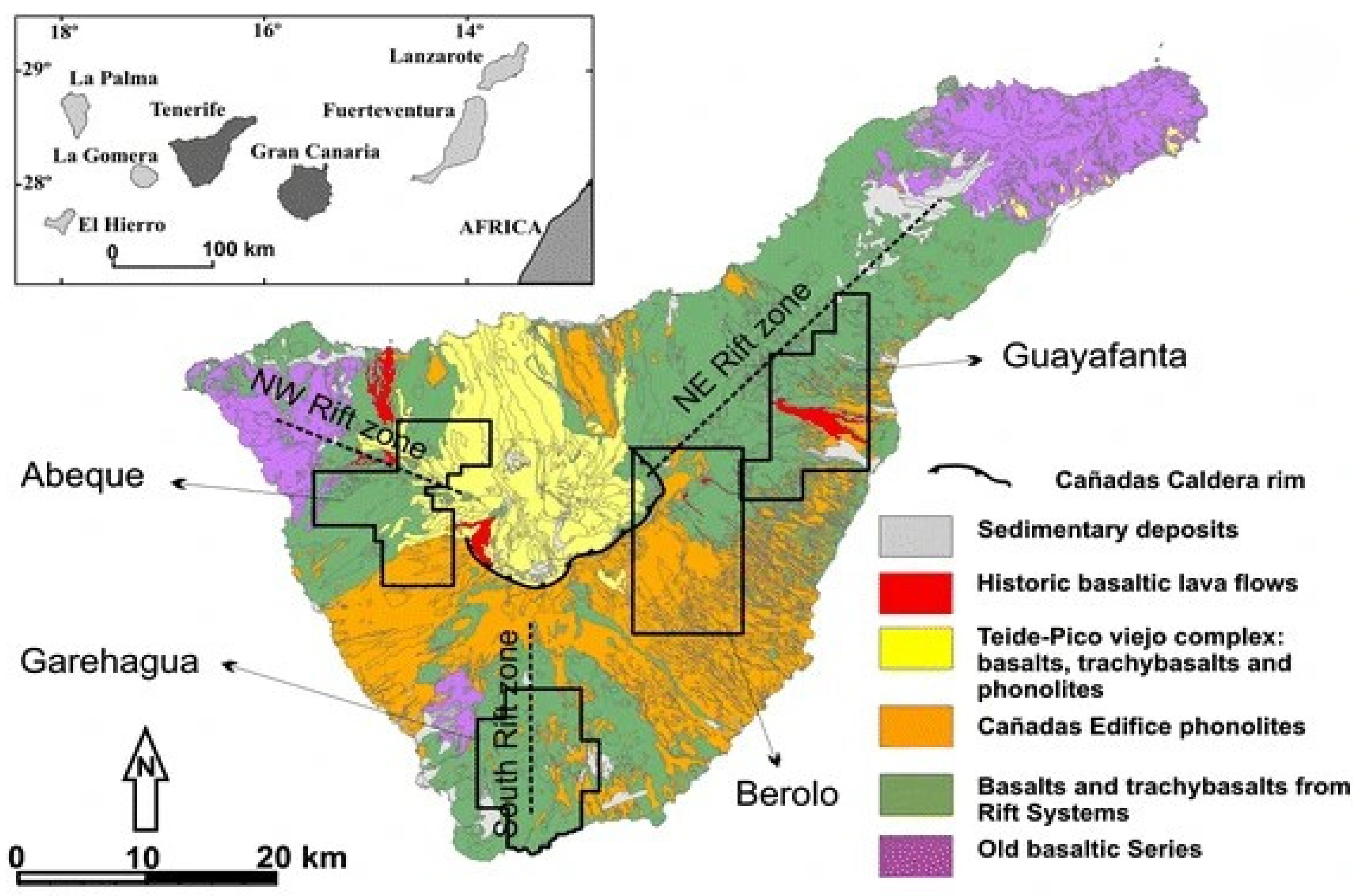
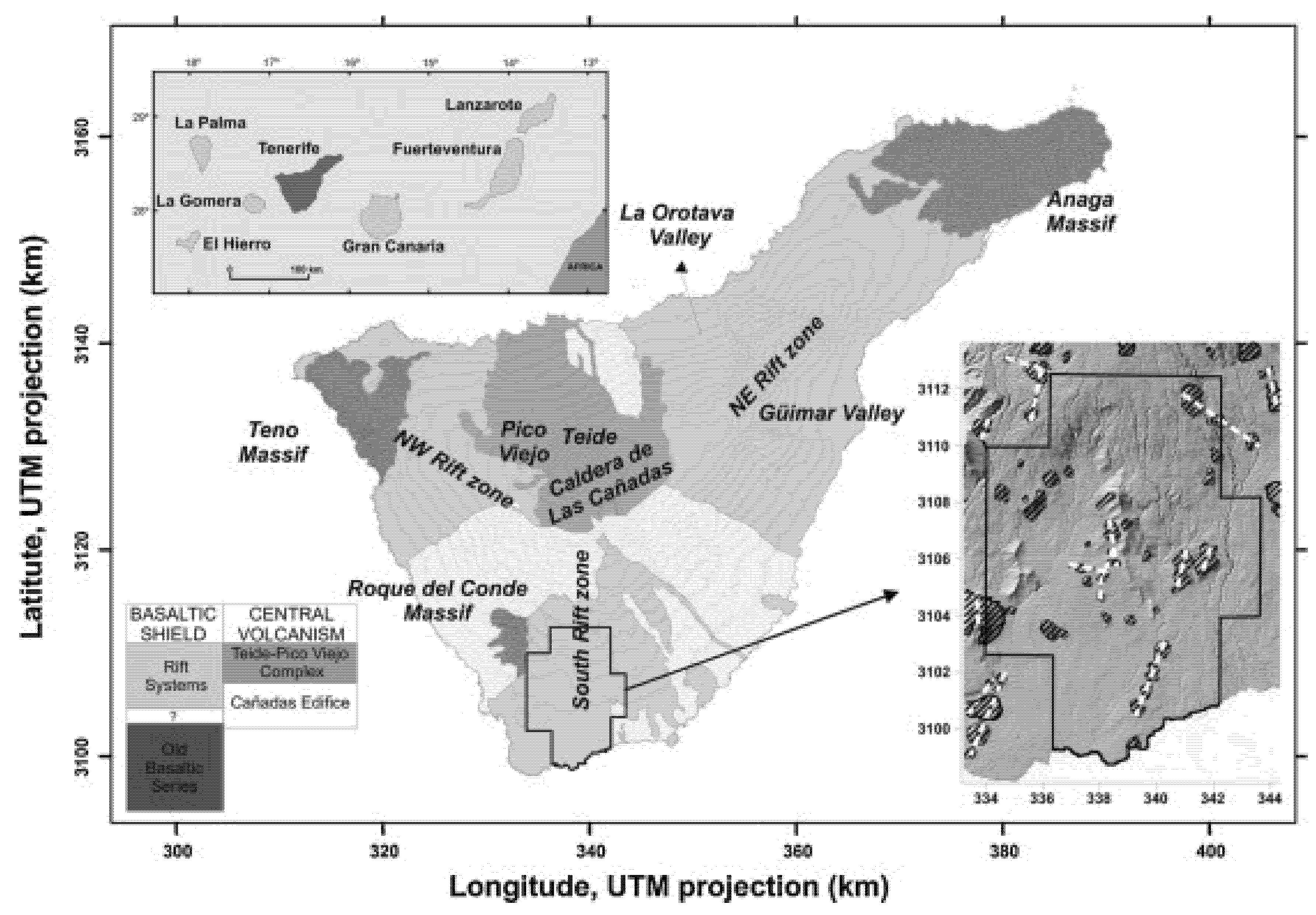
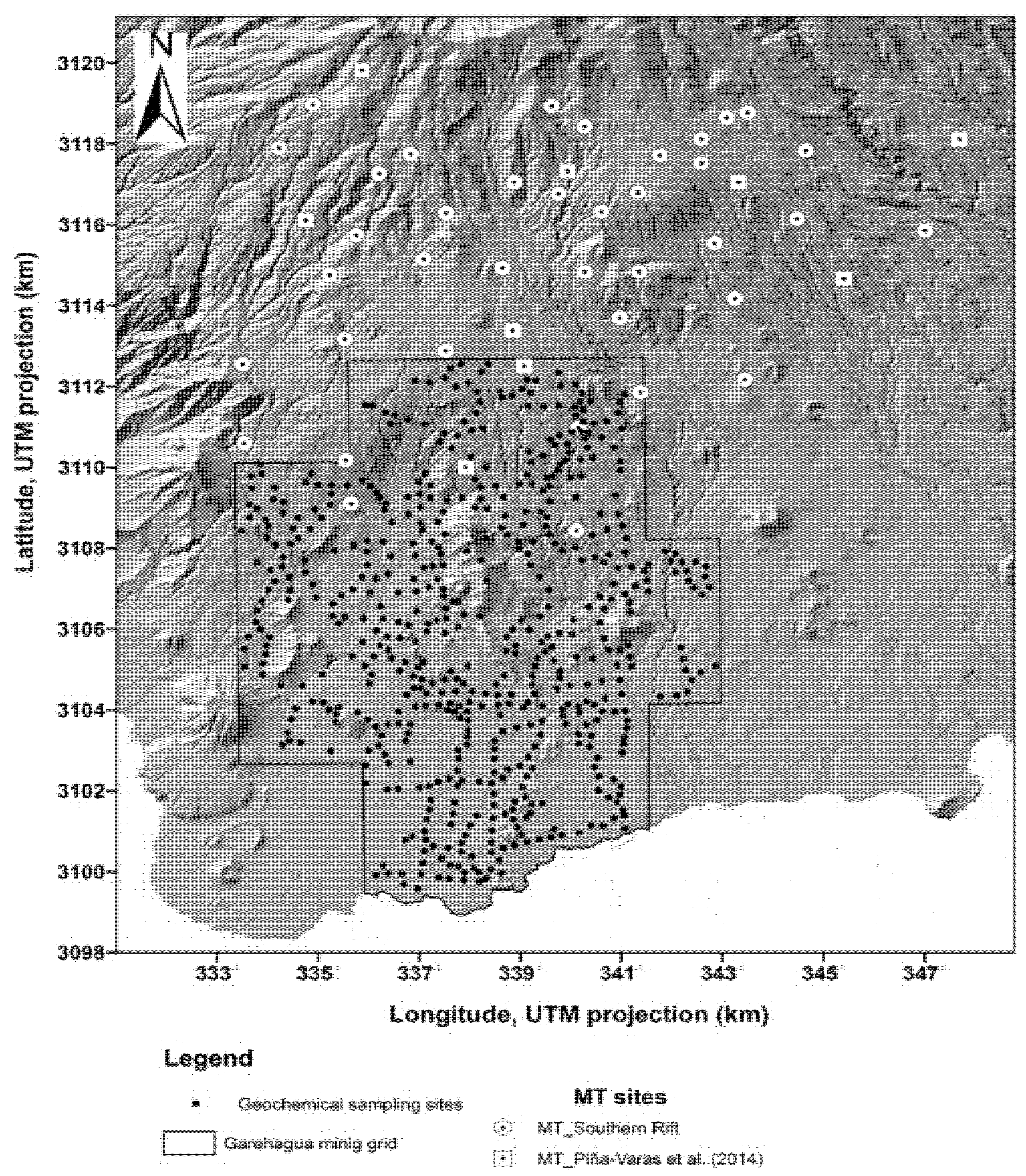

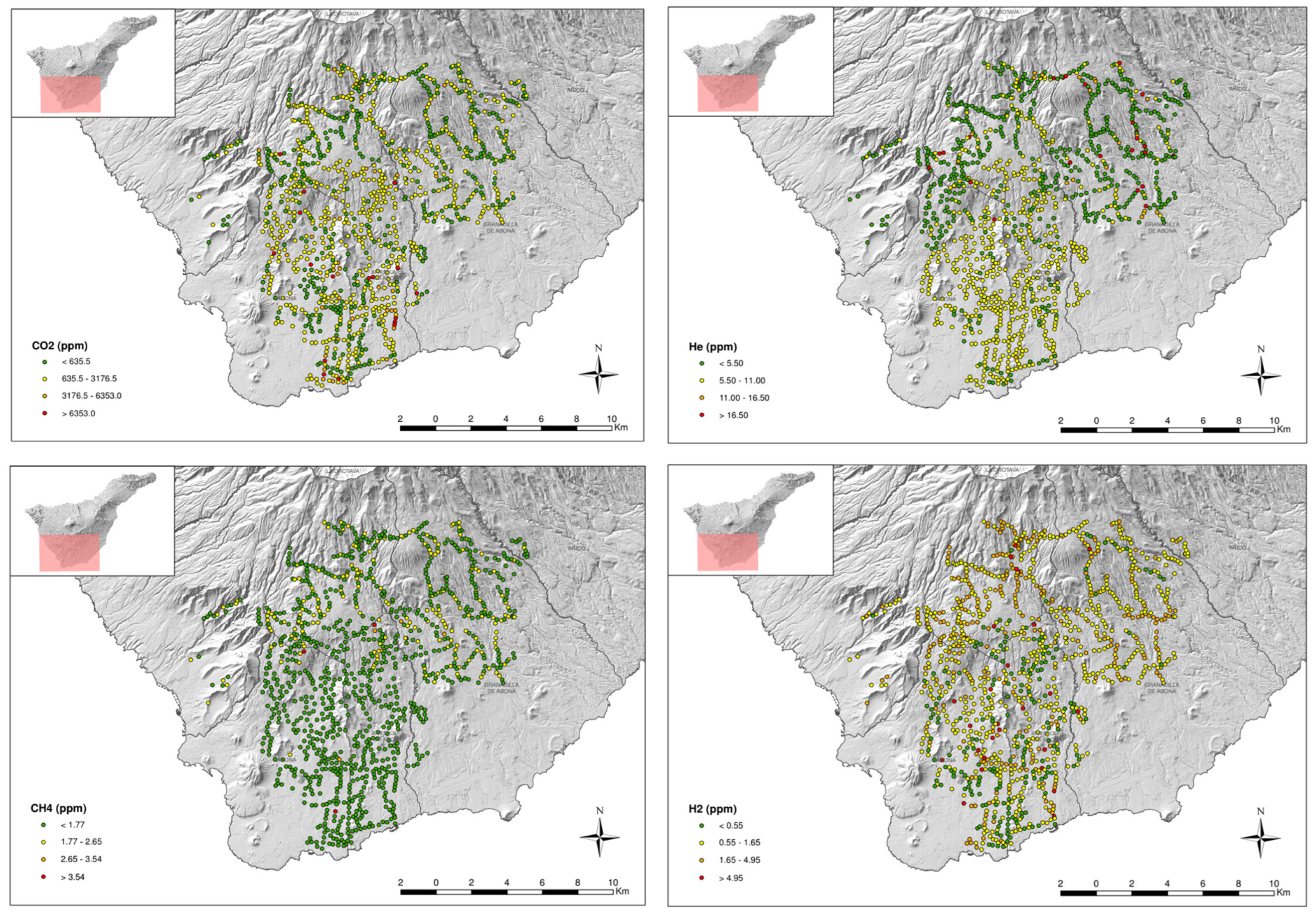
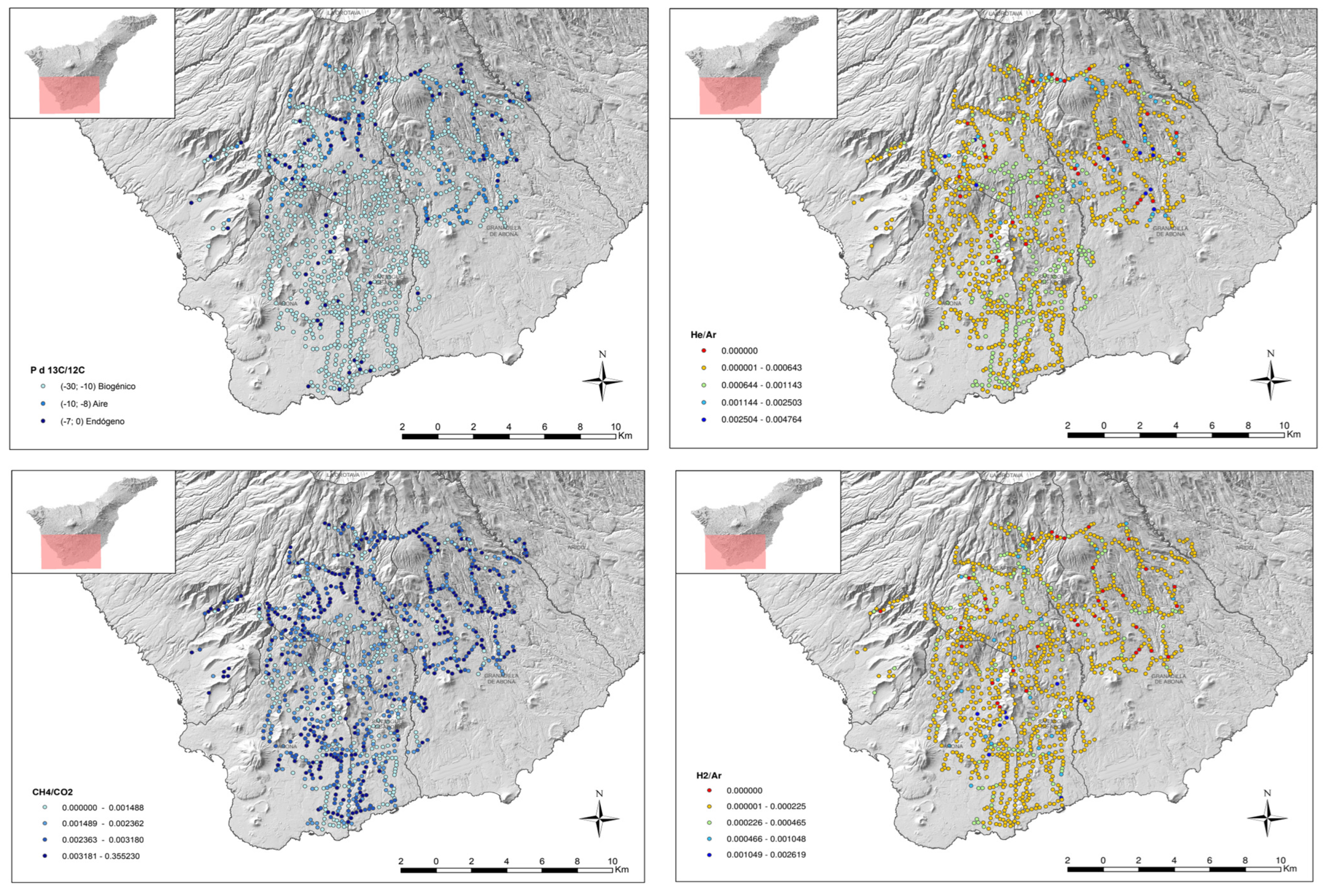
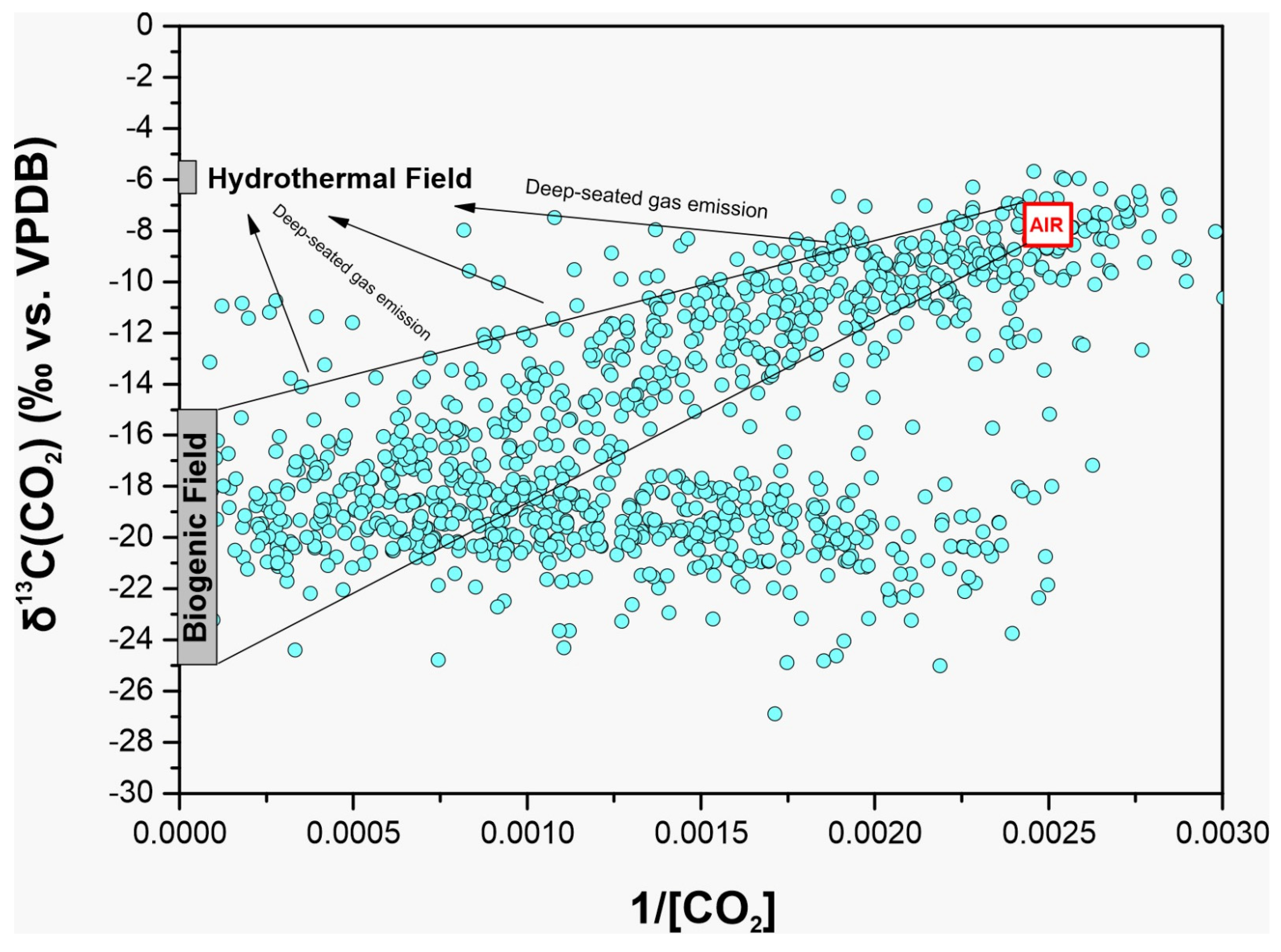
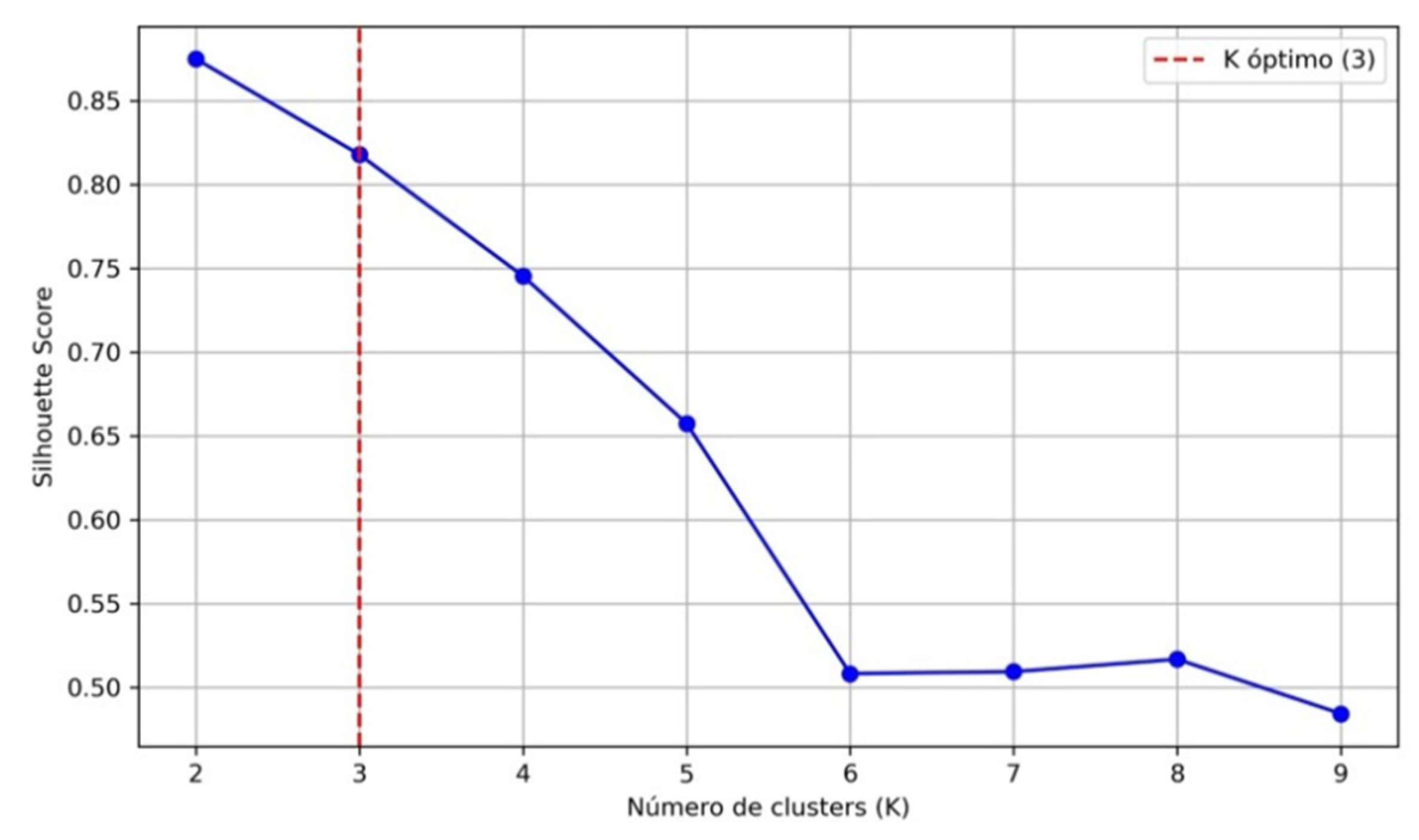
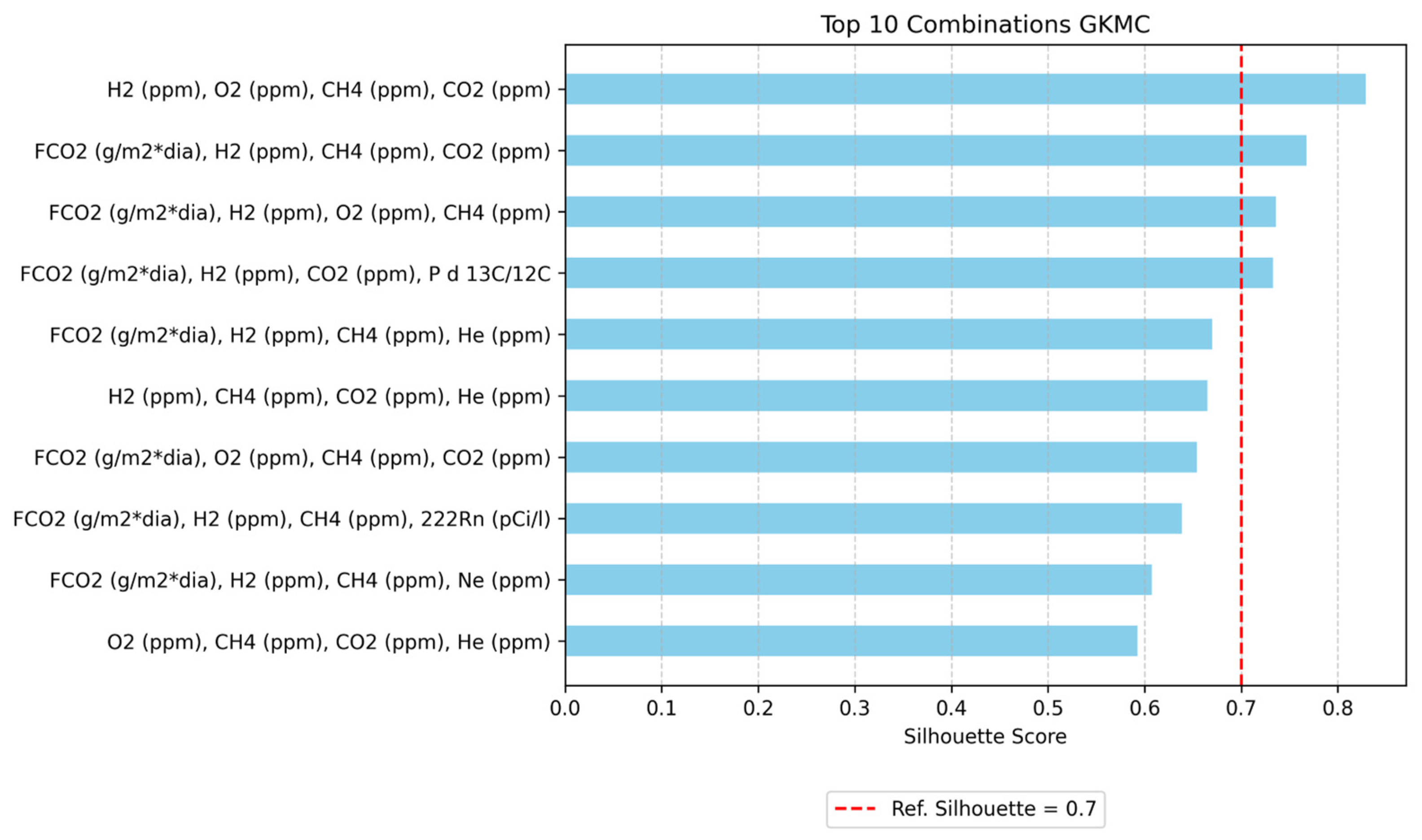
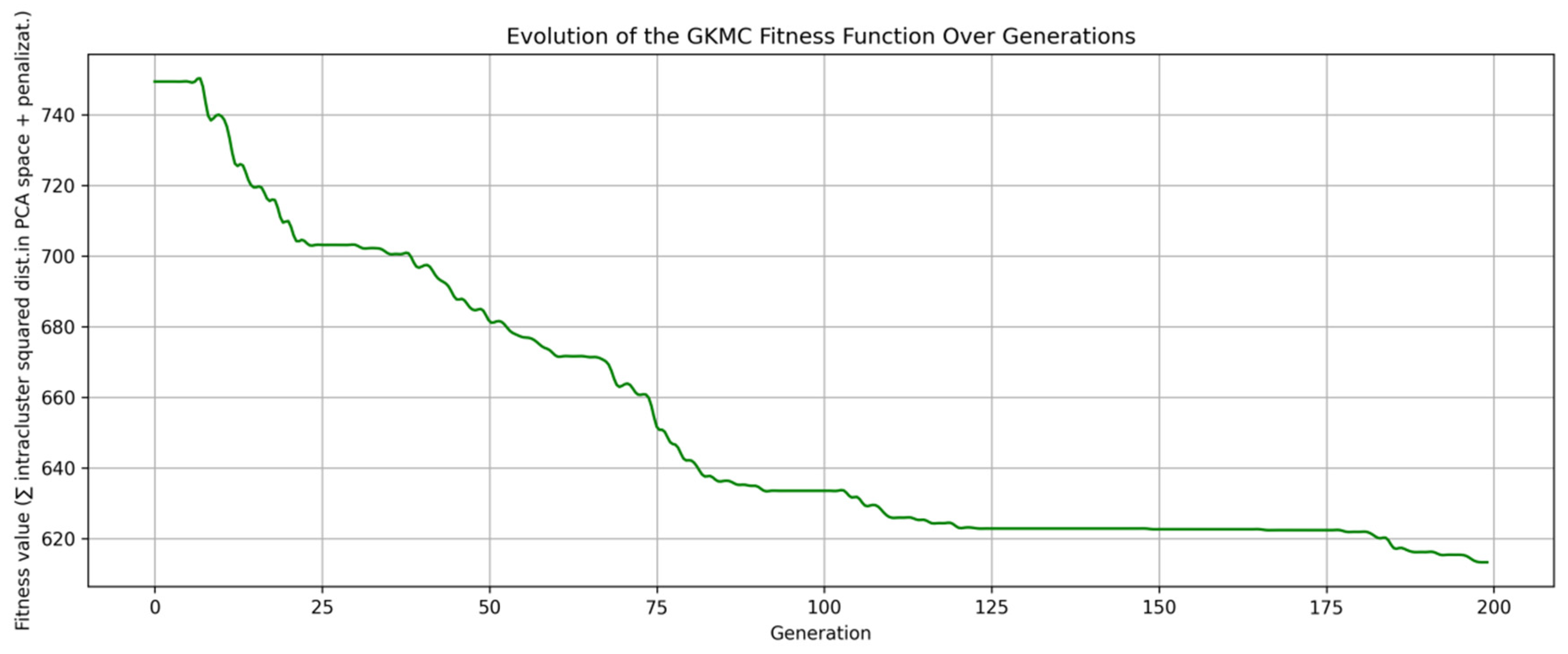
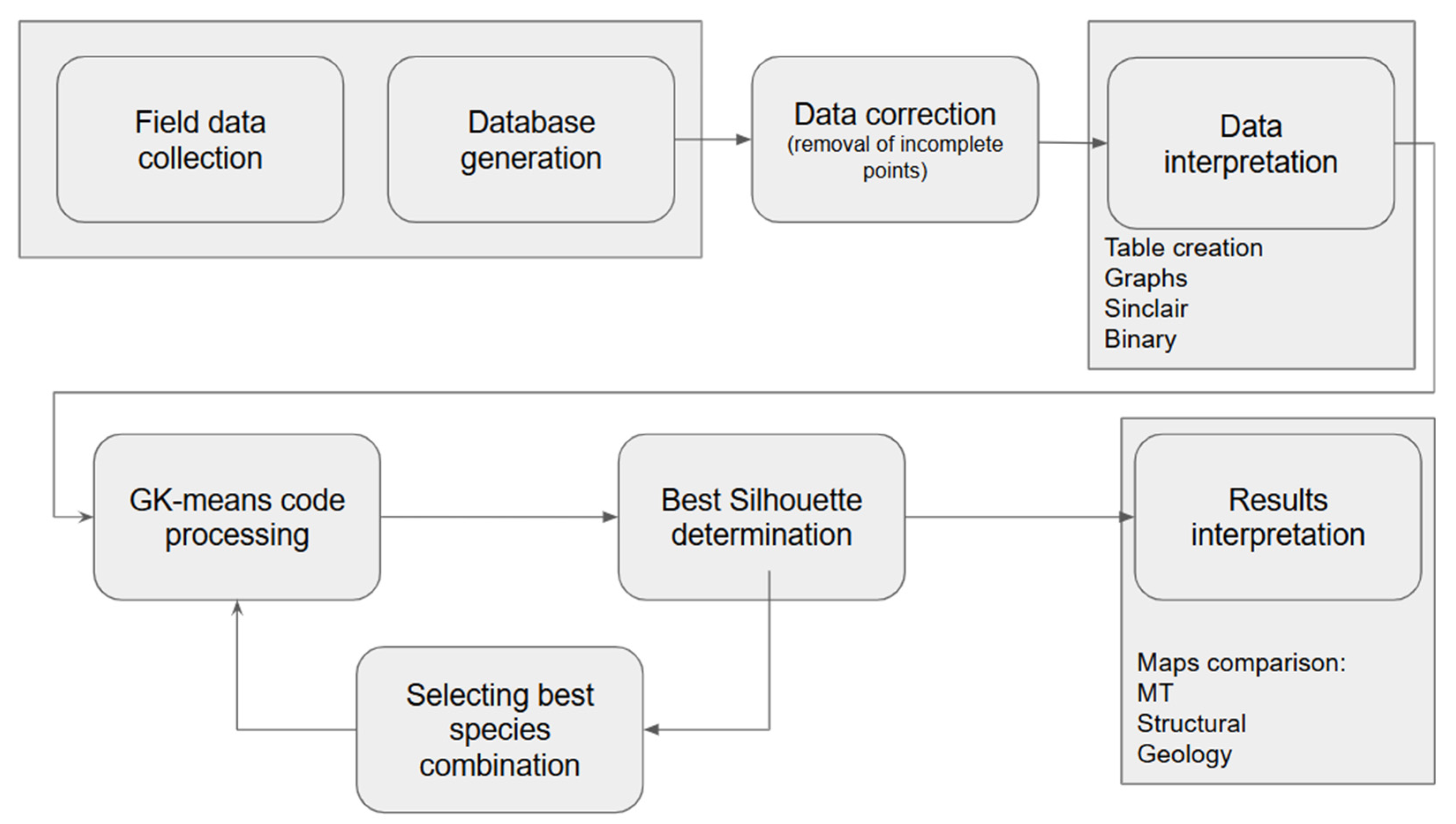
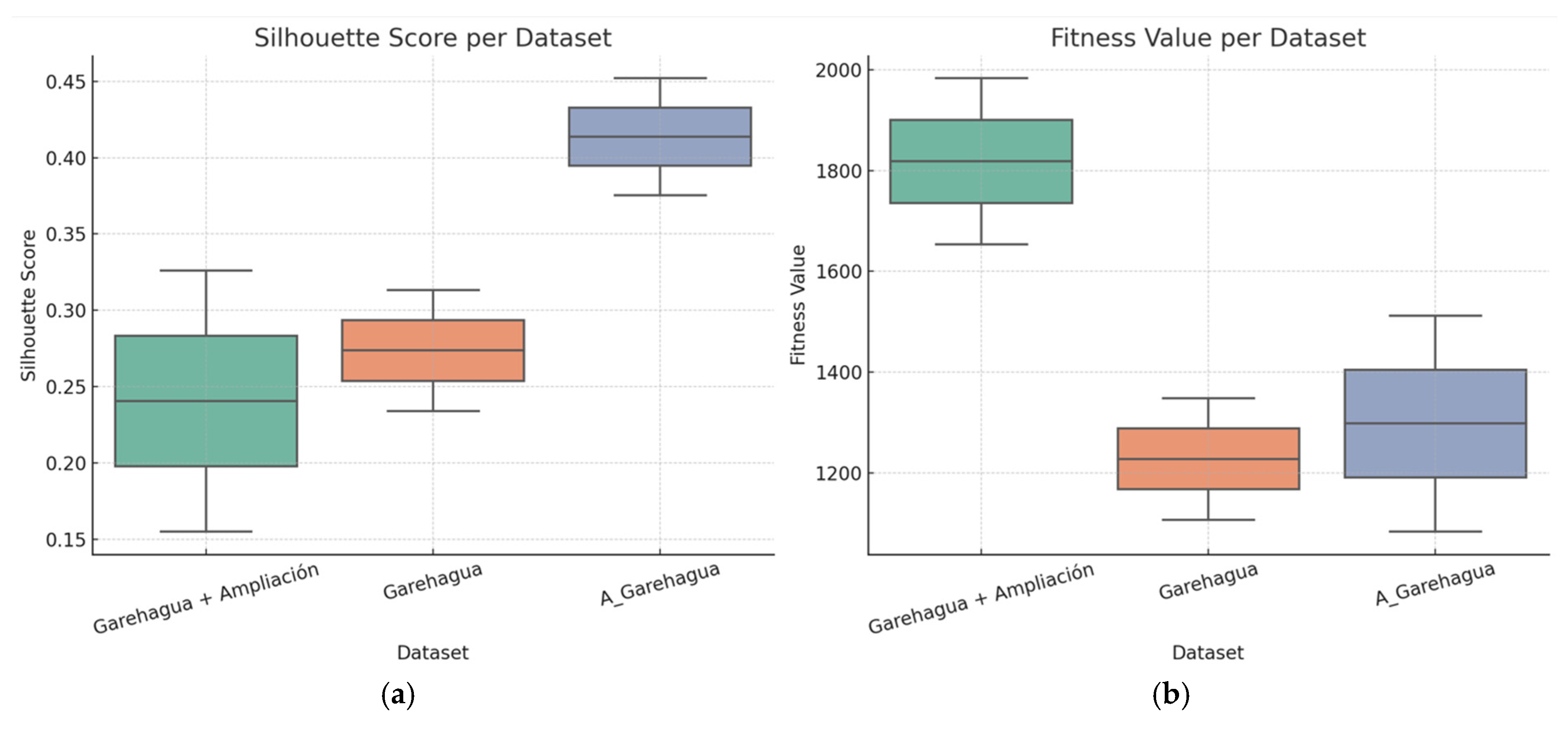
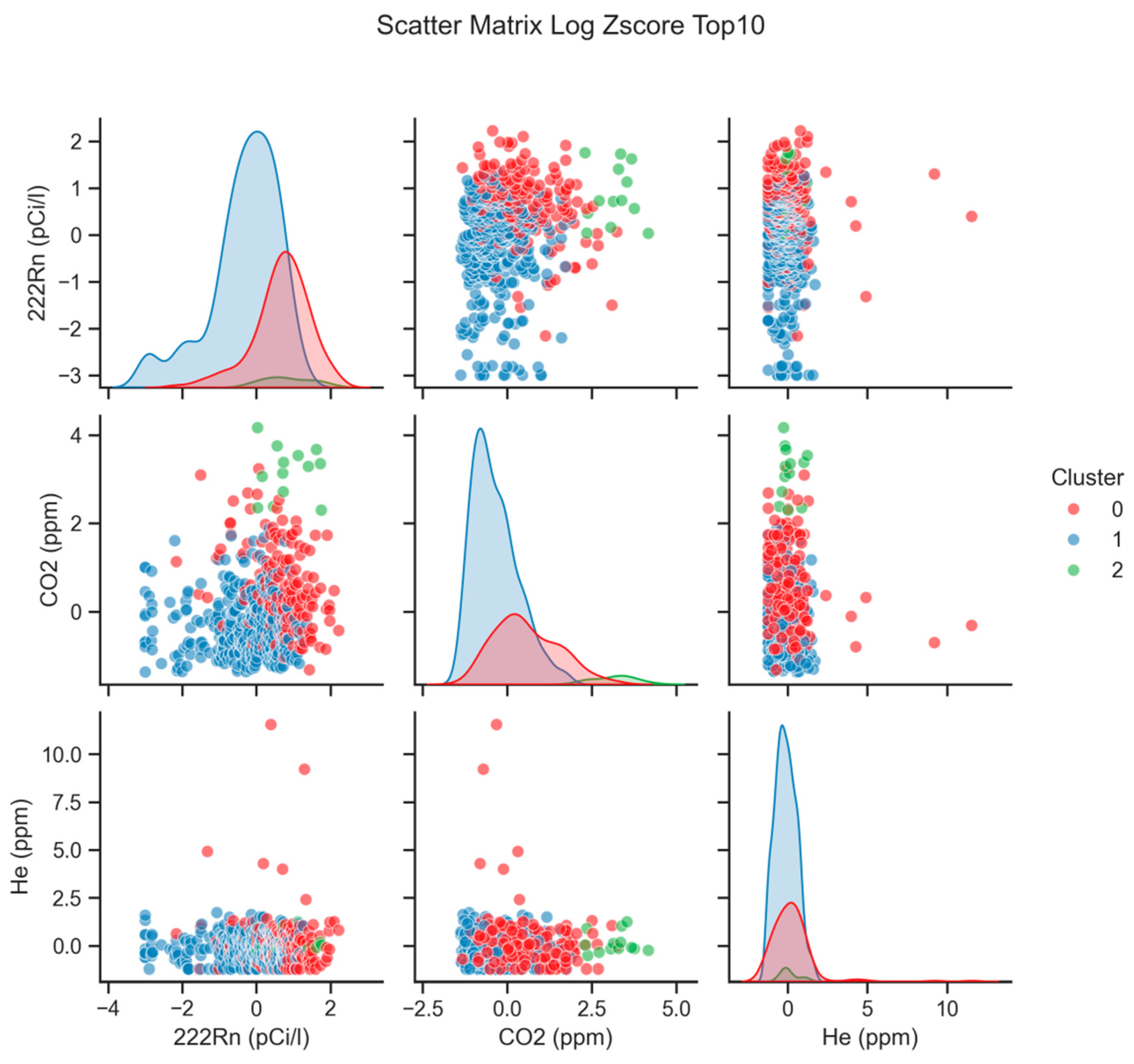
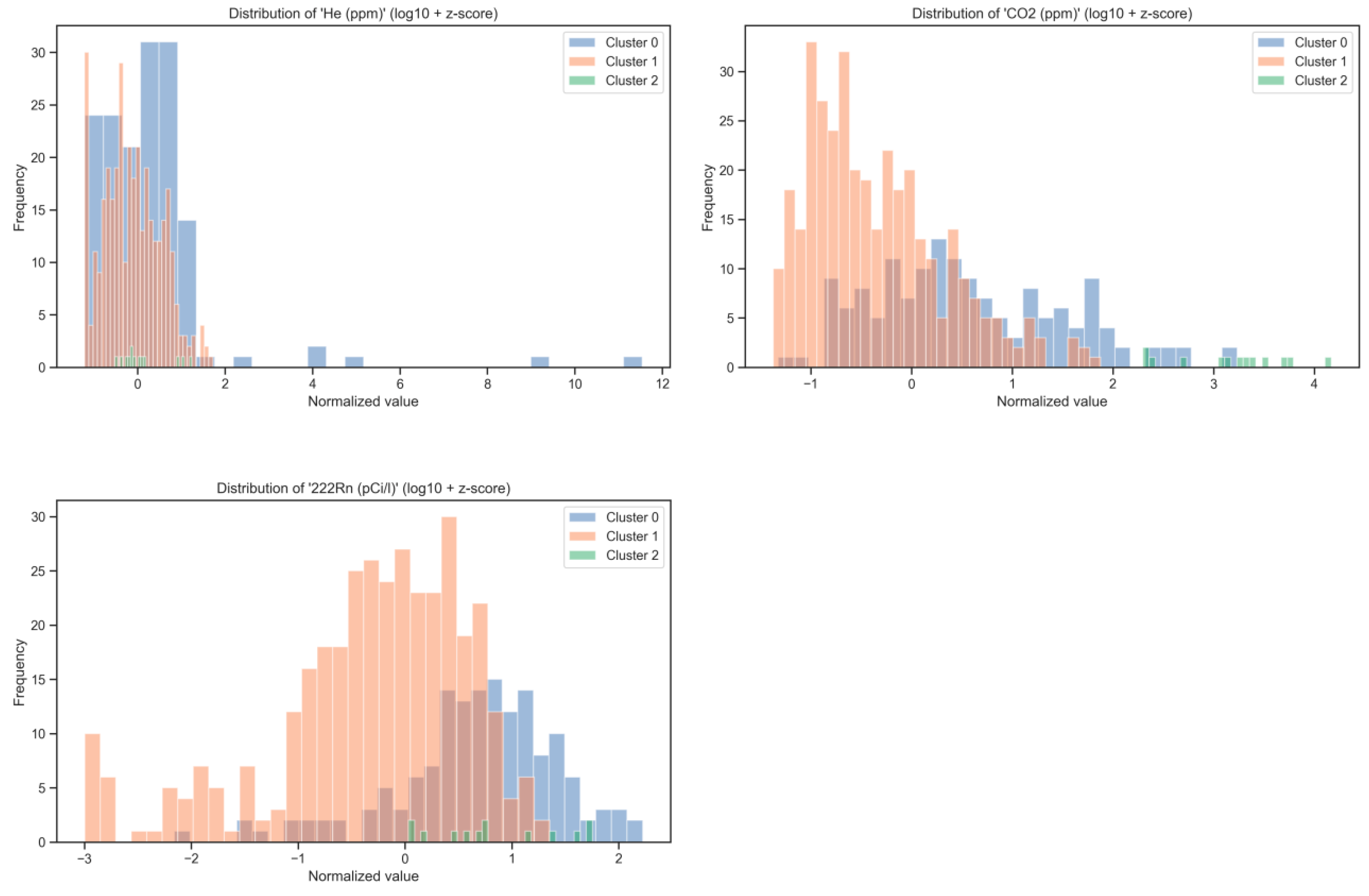
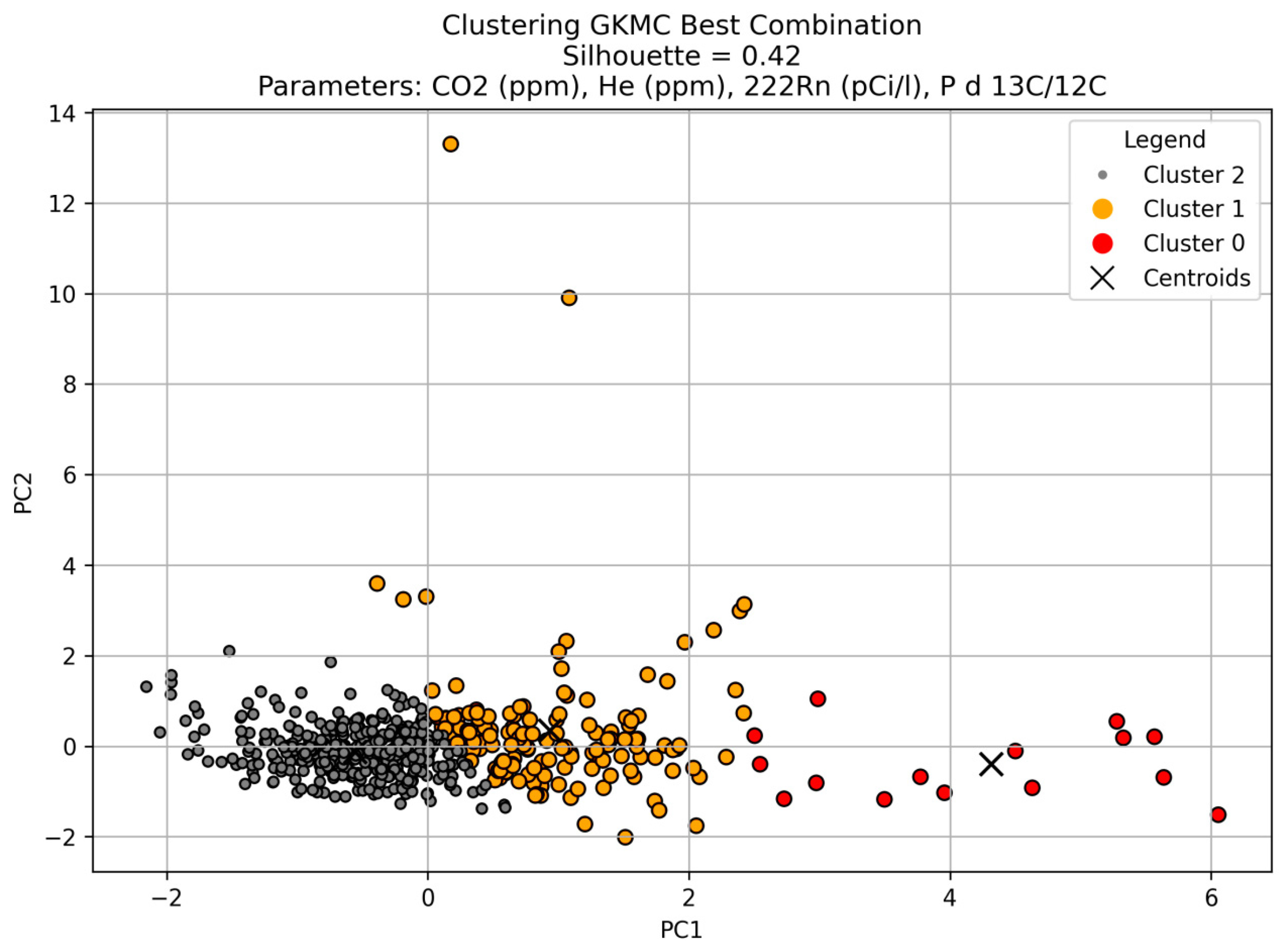
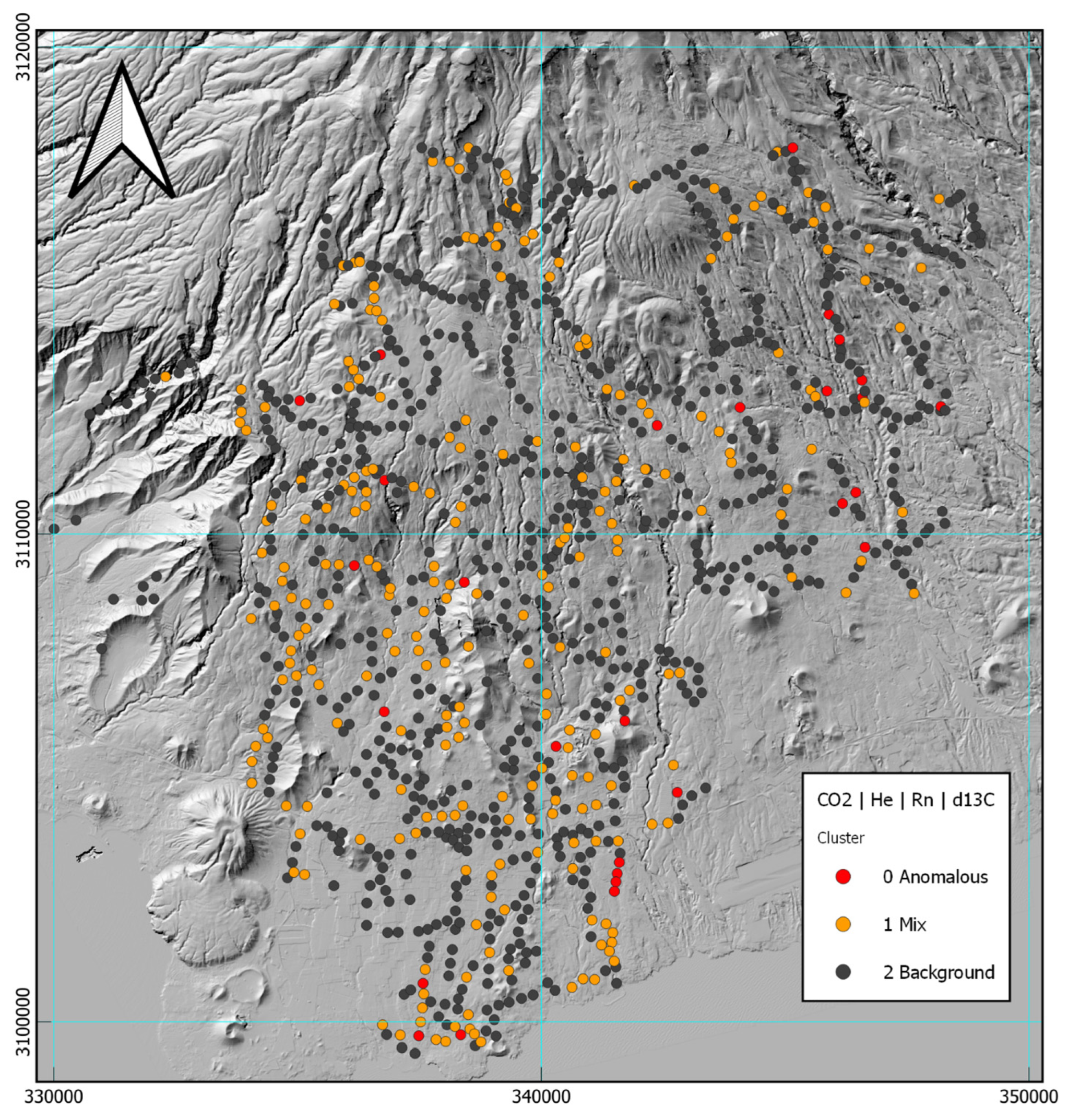
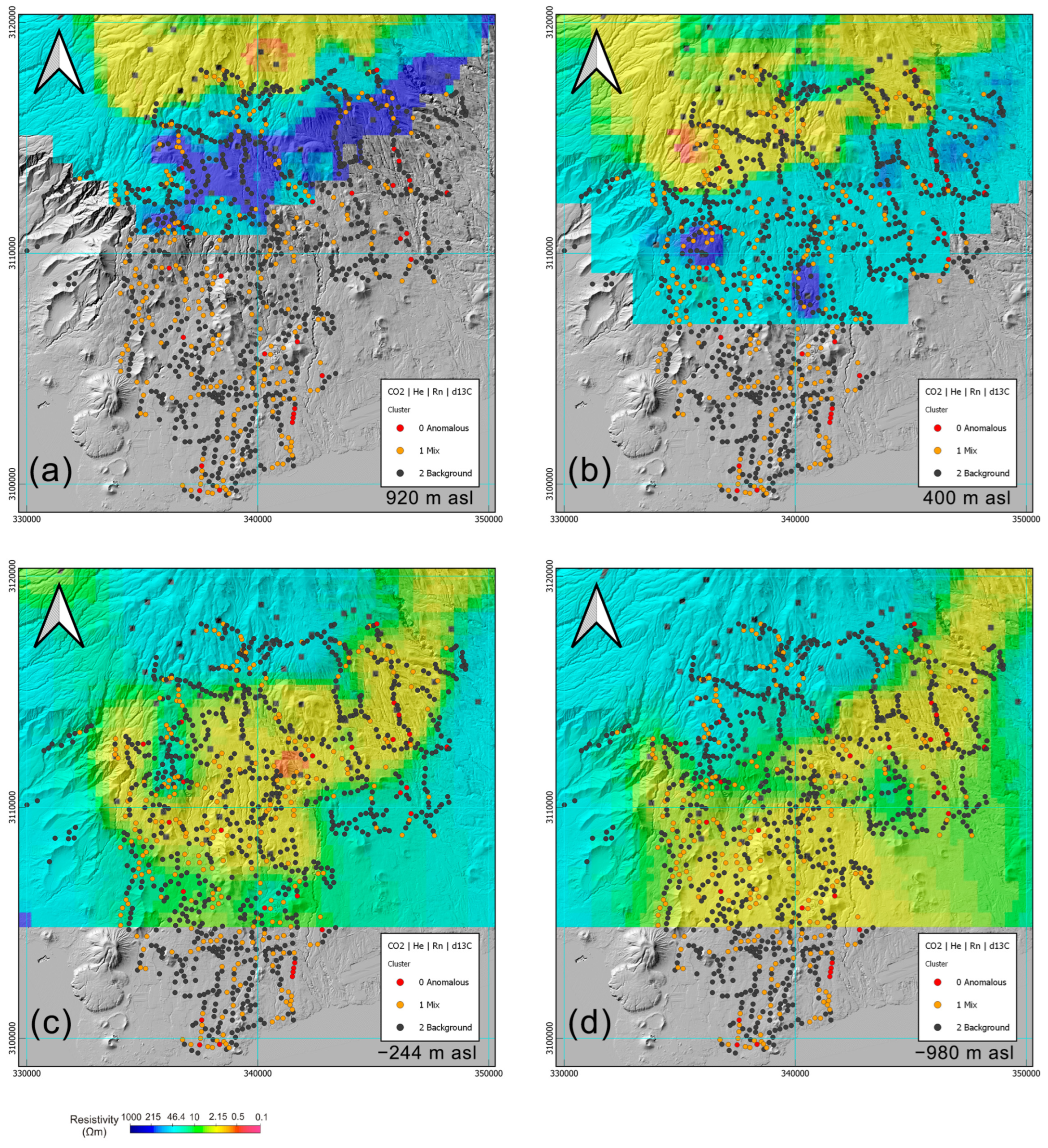
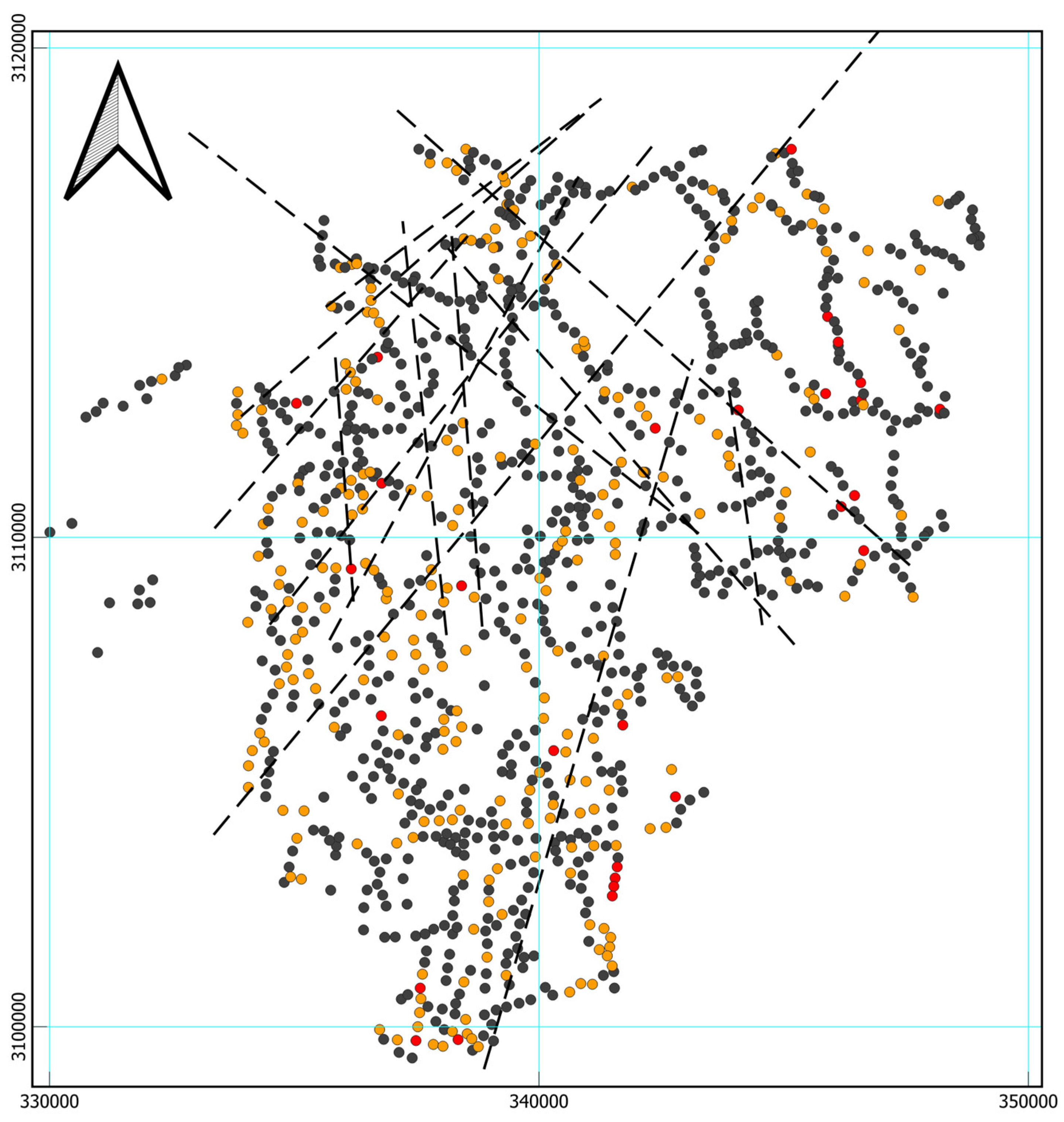
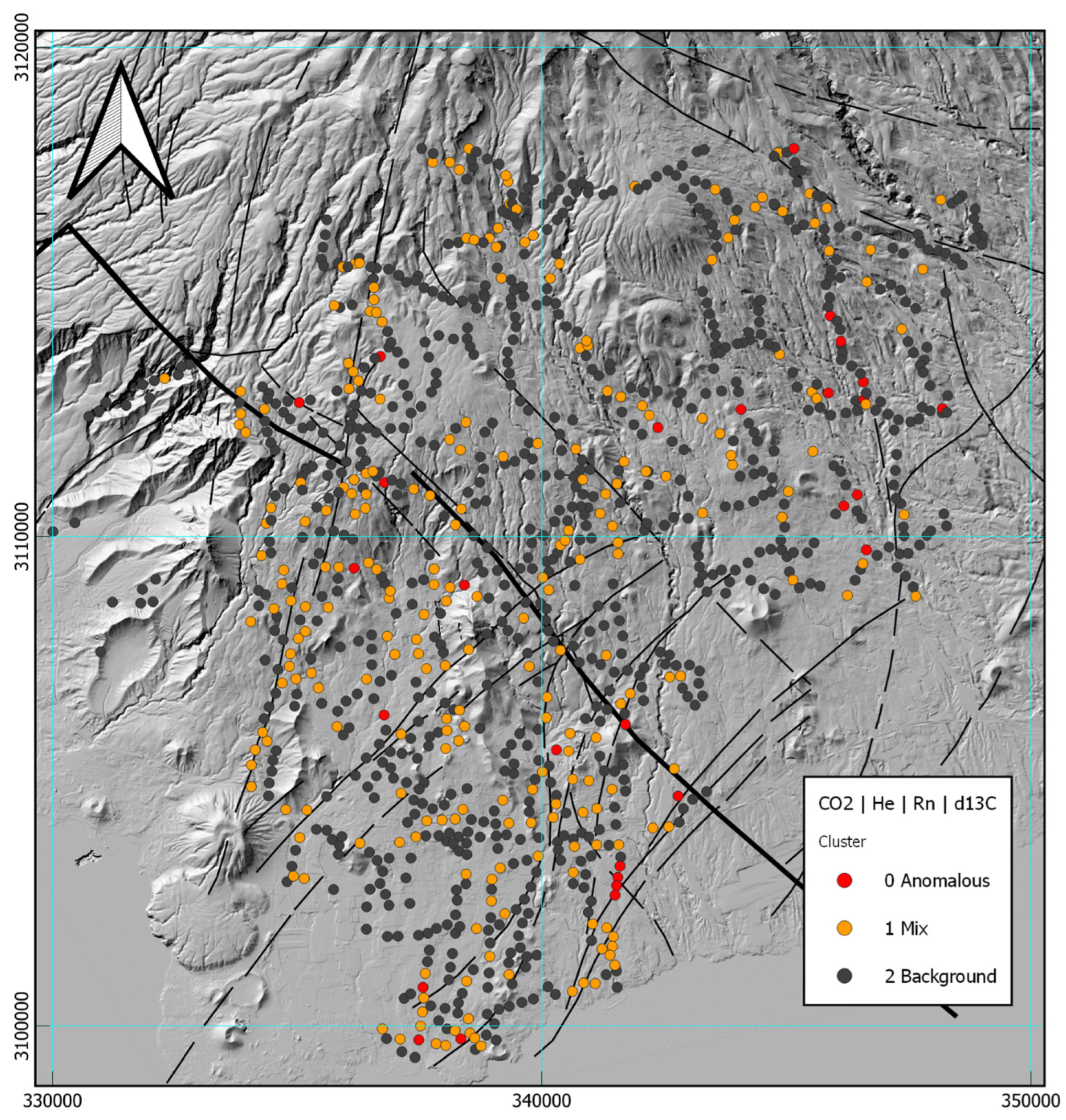
| ID | Parameter | Max. | Min. | Average | Median | SD |
|---|---|---|---|---|---|---|
| 1 | CO2 flow (g m−2 d−1) | 37.7 | <0.50 | 2.2 | 1.44 | 3.0 |
| 2 | Ne (neon) ppm | 18.0 | 17.8 | 17.94 | 17.95 | 0.05 |
| 3 | H2 (hydrogen) ppm | 24.4 | <0.50 | 1.54 | 1.36 | 2.12 |
| 4 | O2 (oxygen) ppm | 213,804.7 | 204,238.3 | 210,794.7 | 210,859.8 | 1141.5 |
| 5 | N2 (nitrogen) ppm | 799,468.6 | 774,063.6 | 788,774.7 | 788,230.7 | 3742.6 |
| 6 | CO2 (carbon dioxide) ppm | 16,151.5 | 355.0 | 909.3 | 648.3 | 1060.9 |
| 7 | CH4 (methane) ppm | 6.37 | 1.70 | 1.80 | 1.76 | 0.25 |
| 8 | He (helium) ppm | 40.0 | 5.24 | 6.85 | 5.28 | 5.39 |
| 9 | 36Ar (argon-36) ppm | 35.74 | 26.74 | 31.52 | 31.3 | 1.6 |
| 10 | 38Ar (argon-38) ppm | 7.90 | 5.32 | 6.25 | 5.9 | 0.2 |
| 11 | 40Ar (argon-40) ppm | 10,740.22 | 7866.75 | 9254.37 | 9351.5 | 559.7 |
| 12 | Ar tot ppm | 10,783.86 | 7898.81 | 9292.14 | 9388.8 | 561.5 |
| 13 | 13C/12C (carbon isotope ratio) | −10.9 | −25.0 | −19.3 | −19.5 | 1.8 |
| 14 | 222Rn (radon) pCi/l | 290.0 | < 0.50 | 43.9 | 33.7 | 40.3 |
| 15 | Tn (thoron 220Rn) pCi/l | 2075.83 | < 0.50 | 46.3 | 23.3 | 186.84 |
Disclaimer/Publisher’s Note: The statements, opinions and data contained in all publications are solely those of the individual author(s) and contributor(s) and not of MDPI and/or the editor(s). MDPI and/or the editor(s) disclaim responsibility for any injury to people or property resulting from any ideas, methods, instructions or products referred to in the content. |
© 2025 by the authors. Licensee MDPI, Basel, Switzerland. This article is an open access article distributed under the terms and conditions of the Creative Commons Attribution (CC BY) license (https://creativecommons.org/licenses/by/4.0/).
Share and Cite
Morales González-Moro, Á.; D’Auria, L.; Pérez Rodríguez, N.M. Genetic K-Means Clustering of Soil Gas Anomalies for High-Enthalpy Geothermal Prospecting: A Multivariate Approach from Southern Tenerife, Canary Islands. Geosciences 2025, 15, 204. https://doi.org/10.3390/geosciences15060204
Morales González-Moro Á, D’Auria L, Pérez Rodríguez NM. Genetic K-Means Clustering of Soil Gas Anomalies for High-Enthalpy Geothermal Prospecting: A Multivariate Approach from Southern Tenerife, Canary Islands. Geosciences. 2025; 15(6):204. https://doi.org/10.3390/geosciences15060204
Chicago/Turabian StyleMorales González-Moro, Ángel, Luca D’Auria, and Nemesio M. Pérez Rodríguez. 2025. "Genetic K-Means Clustering of Soil Gas Anomalies for High-Enthalpy Geothermal Prospecting: A Multivariate Approach from Southern Tenerife, Canary Islands" Geosciences 15, no. 6: 204. https://doi.org/10.3390/geosciences15060204
APA StyleMorales González-Moro, Á., D’Auria, L., & Pérez Rodríguez, N. M. (2025). Genetic K-Means Clustering of Soil Gas Anomalies for High-Enthalpy Geothermal Prospecting: A Multivariate Approach from Southern Tenerife, Canary Islands. Geosciences, 15(6), 204. https://doi.org/10.3390/geosciences15060204






